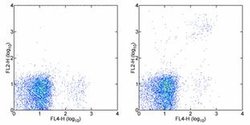Learn More
Invitrogen™ Ly-49A/D Monoclonal Antibody (eBio12A8 (12A8)), PE, eBioscience™
Rat Monoclonal Antibody
Supplier: Invitrogen™ 12578381

Description
Description: The eBio12A8 antibody reacts with Ly-49A and Ly-49D. The Ly-49 family of NK-cell receptors, members of the C-type lectin superfamily, are disulfide-linked type-II transmembrane protein homodimers with extracellular carbohydrate-recognition domains which bind to MHC class I alloantigens. The Ly-49 family members are expressed independently, such that an individual NK or T cell may display more than one class of Ly-49 receptor homodimers. Ly-49D is expressed on subsets of natural killer cells in C57BL/6, C3H/He, and SJL mice, but not DBA/2, AKR, CBA/J, or BALB/c mice. The Ly-49D antigen has not been detected on NK-1.1+ T cells. The Ly-49D receptor has been implicated in mediation of NK cell cytolysis. Ly-49D is an activating receptor while Ly-49A is a inhibitory receptor. eBio12A8 does not react with BALB/c, DBA/2, AKR, or CBA/J Ly-D49D. Applications Reported: This eBio12A8 (12A8) antibody has been reported for use in flow cytometric analysis. Applications Tested: This eBio12A8 (12A8) antibody has been tested by flow cytometric analysis of mouse spleen cells. This can be used at less than or equal to 0.125 μg per test. A test is defined as the amount (μg) of antibody that will stain a cell sample in a final volume of 100 μL. Cell number should be determined empirically but can range from 10^5 to 10^8 cells/test. It is recommended that the antibody be carefully titrated for optimal performance in the assay of interest. Excitation: 488-561 nm; Emission: 5...
The Ly-49 family of NK-cell receptors, members of the C-type lectin superfamily, are disulfide-linked type-II transmembrane protein homodimers with extracellular carbohydrate-recognition domains which bind to MHC class I alloantigens. The Ly-49 family members are expressed independently, such that an individual NK or T cell may display more than one class of Ly-49 receptor homodimers. Ly-49D is expressed on subsets of natural killer cells in C57BL/6, C3H/He, and SJL mice, but not DBA/2, AKR, CBA/J, or BALB/c mice. The Ly-49D antigen has not been detected on NK-1.1+ T cells. The Ly-49D receptor has been implicated in mediation of NK cell cytolysis. Ly-49D is an activating receptor while Ly-49A is a inhibitory receptor.
Specifications
| Ly-49A/D | |
| Monoclonal | |
| 0.2 mg/mL | |
| PBS with 0.09% sodium azide; pH 7.2 | |
| P20937, Q60651 | |
| Klra1, Klra4 | |
| Affinity Chromatography | |
| RUO | |
| 16627, 16635 | |
| 4°C, store in dark, DO NOT FREEZE! | |
| Liquid |
| Flow Cytometry | |
| eBio12A8 (12A8) | |
| PE | |
| Klra1 | |
| A1; CH29-493D4.3; Chok; class I MHC receptor KLRA22; killer cell lectin-like receptor 4; killer cell lectin-like receptor subfamily A member 32; killer cell lectin-like receptor subfamily A member 33; killer cell lectin-like receptor, subfamily A, member 1; killer cell lectin-like receptor, subfamily A, member 4; Klra1; Klra22; Klra32; Klra33; Klra4; Ly49a; ly-49a; Ly49d; Ly-49d; Ly49-d; Ly49o>129>; ly49r>129>; Ly49v; lymphocyte antigen 49a; lymphocyte antigen 49d; natural killer cell receptor Ly49A; novel killer cell lectin-like receptor subfamily A protein; t lymphocyte antigen A1; T-cell surface glycoprotein Ly-49D; T-cell surface glycoprotein YE1/48 | |
| Rat | |
| 50 μg | |
| Primary | |
| Mouse | |
| Antibody | |
| IgG2a κ |
Safety and Handling
The Fisher Scientific Encompass Program offers items which are not part of our distribution portfolio. These products typically do not have pictures or detailed descriptions. However, we are committed to improving your shopping experience. Please use the form below to provide feedback related to the content on this product.
